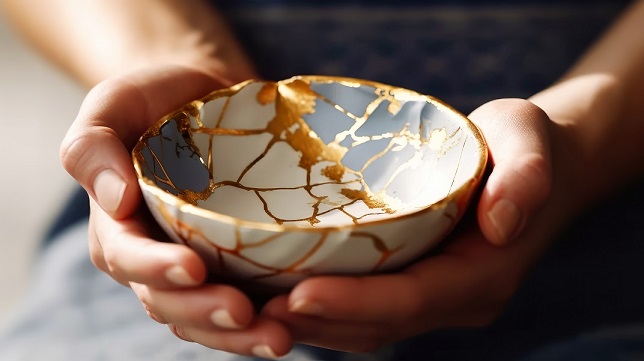Where Brokenness Becomes Beauty
In the delicate dance between fragility and resilience, Japan introduces us to the art of Kintsugi—a practice that transforms brokenness into beauty. Unlike conventional methods of repairing broken pottery, Kintsugi embraces imperfections by mending shattered pieces with lacquer mixed with powdered gold, silver, or platinum. This ancient art form not only resurrects broken objects but elevates them into something uniquely exquisite.
The Philosophy of Kintsugi: Wabi-Sabi in Action
At the heart of Kintsugi lies the philosophy of Wabi-Sabi—a celebration of impermanence, imperfection, and the beauty found in the transient nature of existence. The cracks and fractures in a once-perfect vessel are not concealed but adorned with precious metals, turning flaws into glistening veins that tell a story of resilience and transformation. Kintsugi is not just a method of repair; it’s a visual manifestation of embracing the flawed and finding beauty in the broken.
The Artistic Process of Kintsugi
Crafting a Kintsugi masterpiece requires meticulous skill and an understanding of the inherent beauty within imperfections. The process begins by carefully collecting the shattered pieces of pottery. The artisan then delicately applies lacquer mixed with gold, silver, or platinum to join the fragments, creating lines that shimmer and catch the light. The result is a tapestry of golden seams, each fracture becoming a focal point rather than a blemish.
Symbolism of Golden Repair: Lessons in Resilience
The golden repair in Kintsugi is not just a visual element; it carries profound symbolism. Each crack, once a sign of fracture, becomes a testament to the object’s history and the trials it has endured. The golden lines symbolize healing, resilience, and the strength found in embracing one’s scars. Through Kintsugi, the broken becomes more than whole—it becomes a masterpiece with a story of endurance woven into its very fabric.
Cultural Roots of Kintsugi: From Humble Repairs to High Art
Kintsugi traces its roots back to the 15th century when the shogun Ashikaga Yoshimasa sent a tea bowl to China for repairs. Dissatisfied with the unsightly metal staples used in the repair process, Japanese craftsmen sought a more aesthetic solution, giving birth to Kintsugi. Over time, what started as a pragmatic approach to repair evolved into a revered art form, with contemporary artists pushing the boundaries of tradition while respecting its essence.
Contemporary Resurgence: Kintsugi Beyond Pottery
While traditionally associated with pottery, Kintsugi has found its way into modern expressions of art and design. Beyond bowls and plates, contemporary artists are applying this golden repair technique to everyday objects, clothing, and even technology. The juxtaposition of ancient tradition with modern aesthetics adds a layer of depth to Kintsugi, demonstrating its enduring relevance in an ever-evolving world.
Kintsugi in Everyday Life: Lessons for the Soul
Beyond the artisan’s workshop and the gallery walls, Kintsugi carries lessons for everyday life. It invites us to rethink our approach to imperfections, not just in objects but in ourselves and others. In a world that often demands perfection, Kintsugi offers a gentle reminder that our flaws, scars, and fractures are not marks of inadequacy but stories of resilience waiting to be told.
In Practice: Learning from Kintsugi’s Wisdom
Applying the wisdom of Kintsugi to our own lives involves a shift in perspective. Instead of concealing our scars, we can celebrate them as markers of growth. The challenges we face, the setbacks we endure—each is an opportunity to practice our own form of golden repair, turning moments of brokenness into sources of strength and beauty.
Conclusion: Kintsugi—A Testament to the Beauty of Imperfection
In the delicate alchemy of lacquer and precious metals, Kintsugi transforms brokenness into a celebration of resilience. This ancient Japanese art form, rooted in the philosophy of Wabi-Sabi, invites us to view imperfections not as shortcomings but as unique expressions of beauty. Kintsugi is more than a method of repair; it is a profound cultural practice that teaches us to find grace in our fractures and, in doing so, reveals a path to enduring beauty in a world that often seems too quick to discard the imperfect.











